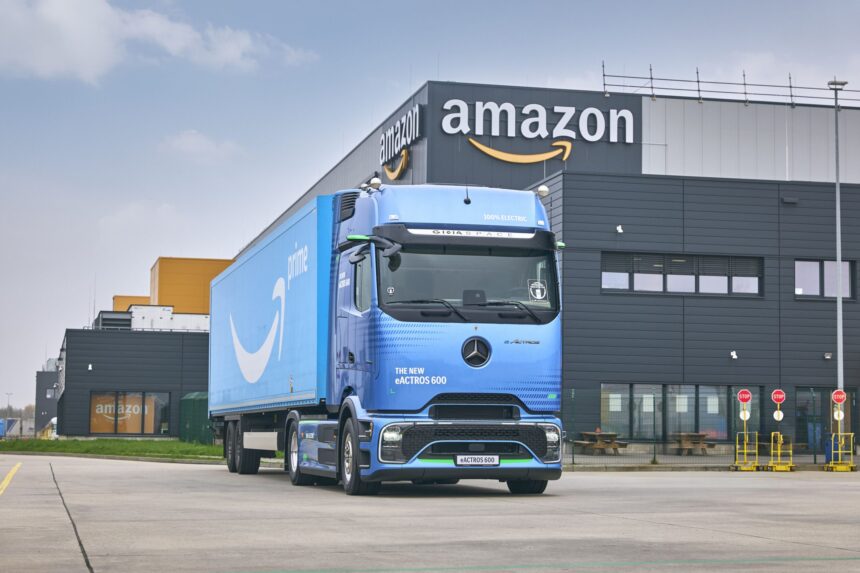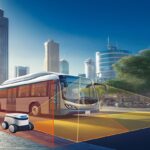Amazon, the e-commerce giant, has made a significant move towards sustainability by placing its largest-ever order of more than 200 battery-electric heavy goods vehicles. The company has selected the flagship Mercedes-Benz eActros 600 from Mercedes-Benz Trucks for this order, marking the largest order for electric trucks in the history of the truck manufacturer.
These electric trucks will be used in Amazon’s middle-mile network, transporting cargo containers to and from the company’s fulfilment centres, sort centres, and delivery stations. With over 140 trucks set to be deployed in the UK and more than 50 in Germany, these zero-emission vehicles are expected to transport more than 350 million packages with zero exhaust emissions.
Prior to placing this order, Amazon conducted practical testing of a near-series prototype of the eActros 600 in one of its logistics centres in Germany. This testing likely provided valuable insights that influenced the decision to go ahead with this substantial order.
In addition to the electric trucks, Amazon also plans to install additional fast-charging infrastructure at its key UK sites. This infrastructure will include 360kW electric charging points capable of charging the eActros 600 trucks from 20 to 80 percent in just over an hour. The eActros 600 trucks have a range of 310 miles (500 km) on a full charge, making them suitable for high-mileage routes.
Karin Rådström, Chairwoman of the Board of Management of Daimler Truck AG, expressed her satisfaction with Amazon’s choice of the eActros 600, calling it a “gamechanger for sustainable transportation.” Stina Fagerman, Head of Marketing, Sales, and Services at Mercedes-Benz Trucks, also emphasized the importance of Amazon as a customer in the journey towards CO2-neutral transport.
Overall, this order signifies a significant step towards sustainability in the transportation industry, with Amazon leading the way by choosing electric trucks for its operations. This move not only showcases Amazon’s commitment to reducing its carbon footprint but also sets a precedent for other companies to follow suit in embracing electric vehicles for a greener future.
To gain a competitive edge in today’s market, businesses must constantly strive to differentiate themselves from their competitors. This can be achieved through various strategies, such as offering superior products or services, providing exceptional customer service, and implementing innovative marketing tactics. One effective way to gain a competitive edge is by staying informed about the latest industry trends and developments.
By keeping abreast of what is happening in your industry, you can identify new opportunities for growth and stay ahead of the competition. This can involve monitoring your competitors’ activities, attending industry conferences and events, and staying up to date with industry news and publications.
Another key way to gain a competitive edge is by leveraging data and analytics to make informed business decisions. By analyzing market trends, customer behavior, and other relevant data points, businesses can identify areas for improvement and optimize their operations for maximum efficiency and profitability.
Additionally, partnering with other industry leaders and experts can also help businesses gain a competitive edge. By collaborating with like-minded companies and individuals, businesses can share knowledge, resources, and best practices to drive innovation and growth.
Overall, gaining a competitive edge requires a combination of strategic planning, market research, and collaboration. By staying informed, leveraging data and analytics, and partnering with industry leaders, businesses can position themselves for success in today’s competitive market. The world of technology is constantly evolving, with new advancements and innovations being made every day. One of the most exciting developments in recent years is the rise of artificial intelligence (AI). AI is a branch of computer science that focuses on creating machines that can perform tasks that typically require human intelligence, such as visual perception, speech recognition, decision-making, and language translation.
One of the key areas where AI has made a significant impact is in the field of healthcare. AI has the potential to revolutionize the way we diagnose and treat diseases, making healthcare more efficient and accessible for everyone. In recent years, AI has been used to develop new diagnostic tools that can help doctors detect diseases earlier and more accurately than ever before.
For example, AI-powered imaging tools can analyze medical images, such as X-rays and MRIs, to identify signs of disease that may be difficult for human radiologists to detect. This can help doctors diagnose conditions like cancer, heart disease, and neurological disorders more quickly and accurately, leading to better outcomes for patients.
AI is also being used to develop personalized treatment plans for patients. By analyzing large amounts of data, AI algorithms can identify patterns and trends that can help doctors tailor treatment plans to individual patients based on their unique genetic makeup, lifestyle, and medical history. This personalized approach to medicine has the potential to improve patient outcomes and reduce healthcare costs in the long run.
In addition to diagnosis and treatment, AI is also being used to improve patient care and streamline hospital operations. AI-powered chatbots can provide patients with instant access to medical information and advice, reducing the burden on healthcare providers and improving the overall patient experience. AI algorithms can also help hospitals optimize their resources, such as scheduling staff and managing inventory, to ensure that patients receive the best possible care in a timely manner.
While AI has the potential to revolutionize healthcare, it also raises important ethical and privacy concerns. As AI becomes more integrated into healthcare systems, there is a need to ensure that patient data is protected and that decisions made by AI algorithms are transparent and accountable. It will be important for policymakers, healthcare providers, and technology companies to work together to develop guidelines and regulations that promote the responsible use of AI in healthcare.
Overall, the rise of AI in healthcare is a promising development that has the potential to transform the way we approach medicine. By harnessing the power of AI, we can improve diagnosis, treatment, and patient care, ultimately leading to better health outcomes for everyone. As technology continues to advance, it will be exciting to see how AI continues to shape the future of healthcare. the perspective of a traveler exploring a remote and exotic destination such as the Amazon rainforest.
As I stepped off the small plane onto the dirt runway, I immediately felt a sense of excitement and wonder wash over me. I had arrived in the Amazon rainforest, one of the most remote and exotic destinations on Earth. The dense canopy of trees stretched out before me, their vibrant green leaves glistening in the sunlight. The air was thick with humidity and the sounds of the jungle surrounded me – the chirping of birds, the buzzing of insects, and the distant roar of a howler monkey.
I had always dreamed of exploring the Amazon, and now I was finally here. I had signed up for a guided tour with a local company that specialized in eco-friendly and sustainable travel. Our guide, a knowledgeable and passionate naturalist, led our small group deep into the heart of the rainforest. As we walked along the narrow trails, he pointed out the countless species of plants and animals that called this place home. I was amazed by the sheer diversity of life that surrounded us – from tiny insects to massive trees that towered overhead.
One of the highlights of my journey was a visit to a remote indigenous village. The people who lived there had a deep connection to the land and the river that sustained them. They welcomed us with open arms, sharing their traditions, stories, and food with us. I was struck by their resilience and resourcefulness, living in harmony with nature in a way that felt almost foreign to me.
As the days passed, I immersed myself in the rhythms of the rainforest. I woke up to the symphony of birdsong each morning and fell asleep to the chorus of frogs at night. I marveled at the intricate patterns of the leaves and the vibrant colors of the flowers. I swam in the cool waters of the river, feeling the powerful current swirl around me. I even tried my hand at fishing with a makeshift bamboo pole, although my catch was meager compared to the skilled locals.
One afternoon, our guide took us on a boat ride down the river. As we glided through the water, I spotted a family of pink dolphins swimming alongside us. Their sleek bodies arced gracefully through the water, their playful antics bringing a smile to my face. I felt a deep sense of gratitude for the opportunity to witness such a magical sight.
As my time in the Amazon came to an end, I knew that this experience would stay with me forever. The beauty and complexity of this ancient ecosystem had left a lasting impression on me. I had learned so much about the delicate balance of life in the rainforest, and the importance of protecting it for future generations.
As I boarded the plane to return home, I felt a mix of sadness and gratitude. I knew that I was leaving behind a place that had touched my soul in ways I couldn’t fully articulate. But I also knew that I would carry the memories of my time in the Amazon with me always, a reminder of the power and beauty of the natural world. And perhaps, one day, I would return to this remote and exotic destination once again, to immerse myself in its wonders and mysteries once more.







